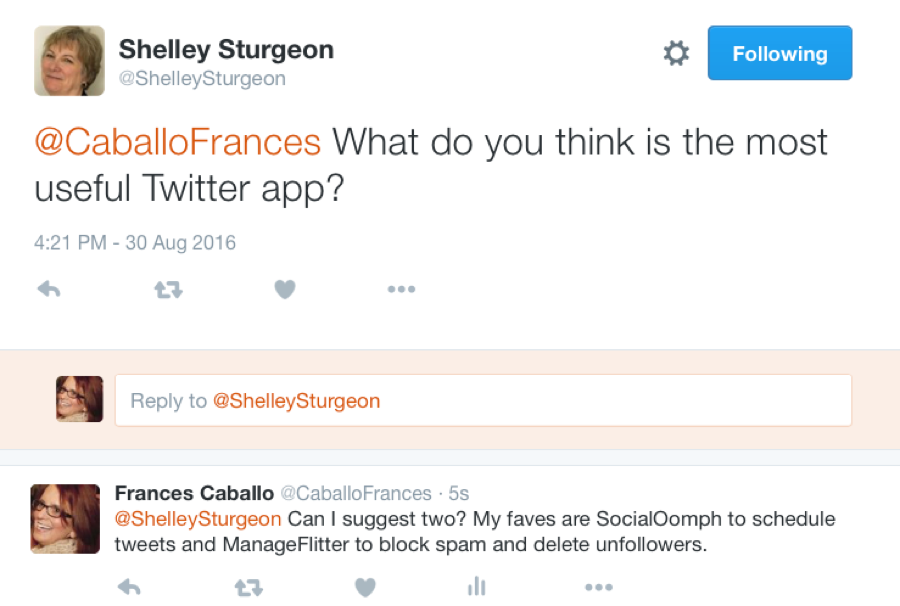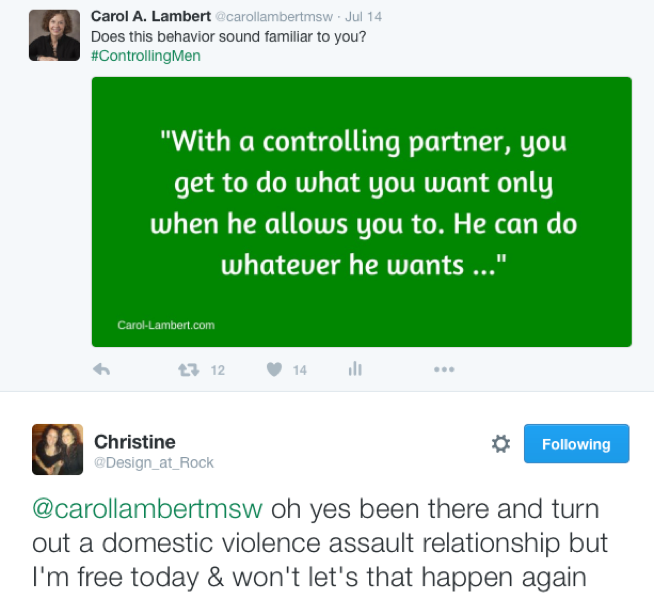
Today’s guest post is from author and social media expert Frances Caballo (@CaballoFrances).
Among all the rules you’ll find online—the 80/20 rule (only 20 percent of your posts should be about your books or blog posts), the admonitions against using social media as a bullhorn, the warnings about over-automating—there’s also an unspoken tenet.
This tenet isn’t a rule that comes up on the blogosphere. Instead, it’s more of a system of approach; to describe it, I use an acronym that I created while preparing for the San Francisco Writers Conference last February.
If you follow the approach I’m about to explain, you can be sure that the time you spend on social media will generate the type of engagement with readers that you want to have.
Ready for the acronym? When you sign up for social media networks, be prepared to CARE about people. I know that it seems self-evident to care about people online, but give me a moment to break down the acronym.
- C—Communicate with your readers.
- A—Answer your readers’ questions.
- R—Relate to your readers.
- E—Educate with stellar content.
And most of all, simply care about people.
Joanna Penn often talks of social karma. As she explains it, if you want book sales, buy books. If you want book reviews, write reviews for all of the books you read. If you want people to like your Facebook page or follow you on Twitter, like your readers’ and friends’ Facebook pages and follow them on Twitter.
Reciprocate actions. And just as you might offer money to a homeless stranger, smile at a person walking down the street, or invite a new family from your church over for tea or dinner, take the types of actions online that will help you to get to know the people who follow you and want to connect with you.
In other words, be kind online. Be inquisitive. Be responsive. Be open to meeting people and revealing parts of your life.
Let’s look more closely at CARE.
Communicate with Your Readers
The most basic tenet of social media is the ability to socialize with others, whether they are your readers, colleagues, friends, or key influencers.
You’ve read blog posts in which bloggers decry those individuals who use social media to communicate too frequently the mantra “Buy my book.” To use social media as a bullhorn to talk about your books, yourself, and your blog posts is the opposite of social media’s basic premise: to socialize with others.
Whether we’re discussing Twitter, LinkedIn, Facebook, or any other social media network, to continuously tweet or post status updates about the availability of your book is a violation of the trust your readers place in you when they decide to follow you or like your Facebook page.
What can you do instead? Communicate with your readers, colleagues, and influencers. Share experiences. Ask questions. Learn about them. Follow them. Share a funny incident. Discuss a common frustration or even fear. Express gratitude.
In the examples below, Mary Mackey, a New York Times bestselling historical fiction and fantasy novelist, received a message from a new follower. See how she responded to the comment, even though it wasn’t about her directly or any books she’d written.
Answer Your Readers’ Questions
How often do you respond to your readers’ questions?
Make sure you’re visiting your notification, comments, and message areas across social media accounts, checking to see if anyone is asking you a question—particularly on days when you’re posting new content.
Sometimes, you won’t find questions, but maybe a reader has left a comment that prompts you to ask a question. You won’t know if you don’t return to your posts.
The A in CARE is also for availability. Part of engaging with readers is being available to them online to address them one on one. Try to schedule fifteen minutes every day to engage.
In this example, I answered a follower’s question:
Relate to Your Readers
Do you really know your readers? You can become familiar with them by asking and answering questions and just talking with them on social media. That’s right, have a conversation; even though the platform can be somewhat stilted, it’s still possible.
For example, I like to thank followers on Twitter for their retweets. On Facebook, I like readers’ and friends’ comments and, if they leave a comment, I might have a follow-up question.
Another way to understand your readers and engage with them is to survey them periodically.
For example, after I’d been blogging for a while, I surveyed my blog readers, asking them to tell me what they most wanted to learn about in the future. I could have blindly decided on social media topics to write about, but engagement increases when I write about the issues already on the mind of my readers. You can do this either informally (through a social media or blog post) or formally, through a free SurveyMonkey account.
Here’s a communication between a former domestic violence survivor and a psychotherapist writing a book on domestic violence and coercive control:
Educate and Entertain
What do key influencers post on social media? If you study their posts you’ll see that they tend to post a mix of tweets and updates that have excellent content and some entertainment value, whether it’s in the form of quotes or memes.
For years, I’ve described Facebook as a balance of the mundane and the meaningful. I define mundane posts as entertaining, and meaningful posts as those with an educational value. It’s especially important to reach a balance between the mundane and the meaningful on Facebook pages.
If you look at my Facebook page, meaningful posts never receive as many comments, likes, or shares as entertaining status updates in the form of quotes and fun memes. But it’s important to post links to valuable content for those fans who do value informative blog posts.
On Twitter, images always receive far more retweets than my tweets about my most researched blog posts. As a former vice president of Yahoo! once told me, “Marketing is about entertaining.” I choose to believe that I would have fewer followers if I didn’t balance the entertaining tweets with valuable information that indie authors need to succeed in publishing and marketing. Marketing statistics back this up. It’s common for visuals on Twitter to increase engagement by at least 25 percent.
The entertaining tweets and status updates are like the frosting on a cake, sugary sweet and fun to eat, but what we really want is the cake, right?
Here’s an example from Peg Fitzpatrick’s account:
Now it’s your turn. How do you approach social media?
For more from Frances Caballo (@CaballoFrances), check out Social Media in 30 Minutes a Day.

Frances Caballo is an author and social media strategist and manager for writers. She’s a regular speaker at the San Francisco Writers Conference, a contributing writer at TheBookDesigner.com, blogger and social media expert for BookWorks, and blogger at Bowker’s Self-Published Author blog. She’s written several social media books, including The Author’s Guide to Goodreads and Social Media in 30 Minutes a Day. Her focus is on helping authors surmount the barriers that keep them from flourishing online, building their platform, finding new readers, and selling more books. Her clients include writers conferences and authors of every genre. Not sure how you’re doing online? Sign up for her free email course.







[…] view post at https://janefriedman.com/not-sure-approach-social-media-care-readers/ […]
Great advice. I think it’s possible to build relationships on Twitter as well, and I respond to all conversational tweets in some way. I scroll my feed many times a day to try and catch all of these.
That said, I don’t individually thank people for RTs very often–I just can’t anymore. Many links I send out get probably 25-40 shares on average, and as high as 100+. I just am unable to keep up, and so I have to decide: what does my audience likely want, for me to thank each RT, wasting hours every day, or to continue to curate great content they can use? I’m pretty sure from the twitter conversations & feedback, it’s the latter. So it’s still all about thinking about the audience and knowing what they want and need. 🙂
Every so often will do a “thank you all for the tweets and shares” post that I hope is meaningful (it really is–I so appreciate that people have taken the time to tweet!)
Hullo Jane! always enjoy your posts and I love your list today. I do manage all four of your points above, some better than others. I’ve tweaked the bit in my bio to reflect more personally what I write. “…I write stories of identity conflict. … For all who have ever wondered who you are or why you’re here…” to identify with readers. The educate bit, still working to do better at that one! (and reading your posts helps with that a lot!! wink wink)
Thank you, Robin! Credit goes to Frances today, it’s her list. 🙂
apologies to Frances!! In my defense, it was before-coffee-A.M.
[…] Not Sure How to Approach Social Media? (Jane Friedman) Among all the rules you’ll find online—the 80/20 rule (only 20 percent of your posts should be about your books or blog posts), the admonitions against using social media as a bullhorn, the warnings about over-automating—there’s also an unspoken tenet. […]
Responding to social media comments and questions is so important. The whole point of social media is to be social, after all. If you aren’t responding but merely pushing out content every day, it’s clear that you have it automated.
Frances always has actionable info to share, but this simple CARE code will stick in my mind. I think it is important to consciously get your system in place, whether using smartphone for Twitter, computer for Facebook, etc etc., so that being responsive flows easily.
[…] Not Sure How to Approach Social Media? CARE about Your Readers | Jane Friedman […]
[…] Sharing is C.A.R.E-ing […]